Using TikTok ads for survey recruitment: a step-by-step approach
TikTok’s rapid growth and diverse user base present social science researchers with a unique opportunity to study a large and varied population, gaining valuable insights into their attitudes and behaviors. Unlike platforms such as Facebook and Instagram, TikTok’s potential in survey recruitment has been relatively underexplored. The platform’s cost-effective reach and detailed targeting parameters make it particularly appealing for reaching traditionally hard-to-reach or rare populations. Furthermore, with its video-centric format and predominantly young user base, TikTok provides a means to engage and attract respondents from younger generations to participate in online surveys. In this Methods Bites Tutorial, Zaza Zindel and Simon Lütkewitte (Bielefeld University) provide a step-by-step guide on how to use TikTok ads for survey recruitment.
After reading this blog post, readers should be able to:
- understand how to use TikTok ads for survey participant recruitment
- set up targeted TikTok ad campaigns
- analyze and evaluate the performance of ad campaigns and make necessary adjustments
Note: This blog post supplements Zaza Zindel’s workshop in the MZES Social Science Data Lab. The original workshop materials, including slides and scripts, are available from our GitHub. A live recording of the workshop is available on our YouTube Channel.
Overview
Introduction to social media survey recruitment
Recruiting research participants is a crucial component of any survey study. However, traditional recruitment methods, such as random walk procedures or random digit dialing, can be time-consuming and expensive. With the growing popularity of social media, platforms like TikTok provide a unique opportunity to quickly and effectively recruit a diverse range of survey participants. TikTok is a popular social media app that allows users to create and share short-form videos with a global audience. With a self-reported number of over 1 billion active users, the platform has gained immense popularity, particularly among younger generations (TikTok, n.d.). TikTok is relevant and interesting for social science research due to its unique format and engaging nature. The app provides a window into the cultural and social trends of different communities, making it an attractive platform for studying human behavior and attitudes. Additionally, TikTok’s algorithm allows for a personalized feed, meaning that users are served content based on their interests and behaviors. This feature makes it an interesting platform for reaching and studying specific populations.
As a potential tool for survey recruitment, TikTok ads offer several advantages. The platform’s vast and diverse user base provides researchers with access to a broad range of potential participants, while its targeting options allow them to reach very specific populations that may be difficult to reach through more traditional recruitment channels. Unlike social media platforms like Facebook and Instagram, TikTok’s structure revolves around short-form videos set to music, offering a unique and visually engaging format that researchers can utilize to capture users’ attention and encourage their participation. By leveraging visually appealing videos, researchers can create compelling survey invitations, enhancing the overall survey experience. Furthermore, TikTok’s predominantly young user base sets it apart from other platforms, making it particularly valuable for studies targeting younger demographics. This demographic distinction allows researchers to gain insights from a generation with unique attitudes, behaviors, and perspectives, ultimately contributing to a more comprehensive understanding of societal trends and dynamics.
Recruiting via TikTok – a step-by-step guide
In the following section, we will walk you through the step-by-step process of setting up advertisements on TikTok. We will highlight the important factors you need to consider in order to generate a diverse and comprehensive sample for a web survey.
The TikTok Ads Manager
Having an active TikTok account is the first step towards advertising and recruiting survey participants on TikTok. This is because only individuals and organizations with registered business accounts are allowed to run ads on the platform. To register for a business account, go to the TikTok for Business website and proceed by clicking the “Create Now” button (see Figure 1).
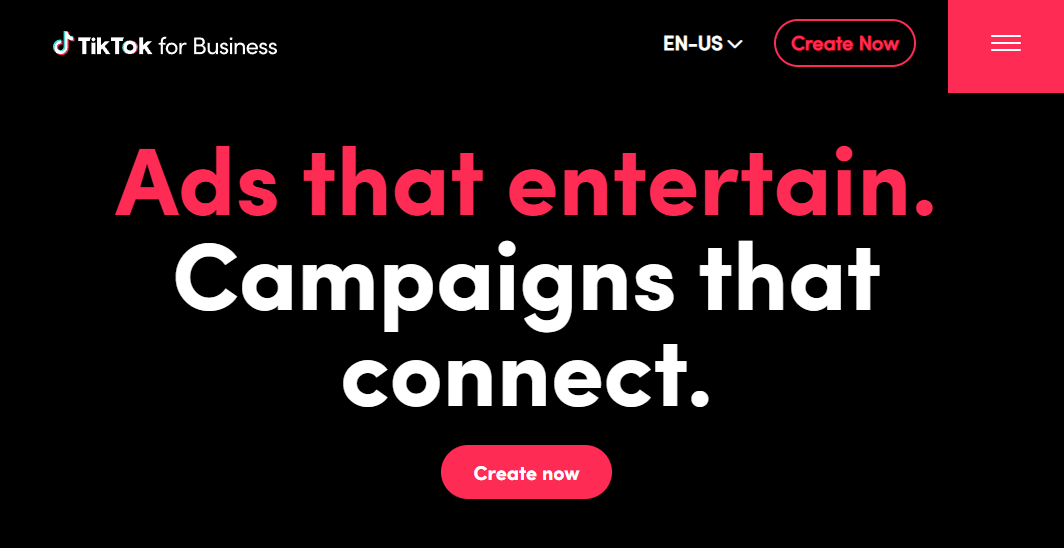
Figure 1: Starting page of TikTok for Business website.
Source: Tik Tok for Business
From there, follow the prompts to sign up for a new account. You will need to provide basic information such as your email address and a password to create an account. Once you have an account, you can proceed to set up your business profile (see Figure 2). This includes providing information such as your company name, industry and country. Make sure to accurately and clearly represent your business, as this will help to build trust with potential survey participants.
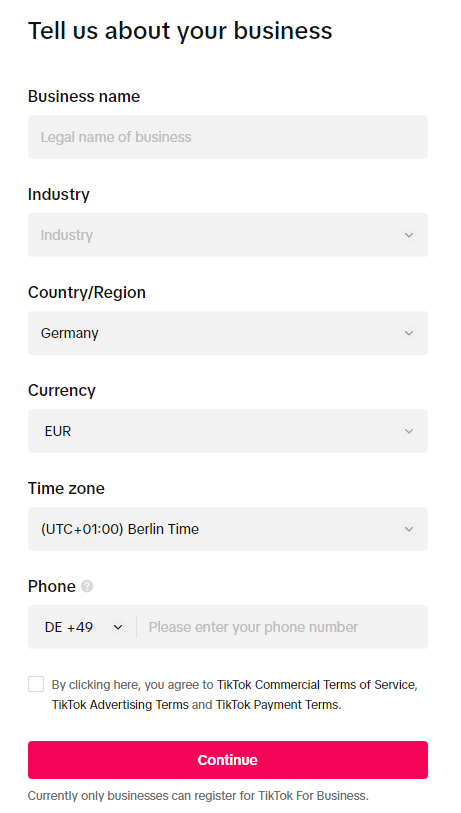
Figure 2: TikTok for Business profile.
Setting up an ad campaign
When creating an advertising campaign on TikTok, it is important to familiarize yourself with the campaign structure. The campaign settings are structured into three distinctive hierarchical levels: campaign level, ad group level, and ad level (see Figure 3). Within the ad campaign, you create ad groups, which serve as subdivisions allowing for further targeting refinement. Each ad group can contain multiple individual ads that serve as the creative content displayed to TikTok users. This means that within a single ad campaign, you can create multiple ad groups, and within each ad group, there can be multiple ads. Each level requires making informed choices and providing necessary information to ensure the effectiveness of your ad campaign.

Figure 3: TikTok ad hierarchy.
Campaign level
At the campaign level, the first step is to choose the campaign objective that best aligns with your advertising goal. This decision will determine how TikTok will optimize the ad delivery. TikTok offers three main categories of campaign objectives: awareness, consideration, and conversion (see Figure 4). Each category serves a distinct purpose in terms of user interaction with your ad and the desired actions you want users to take.
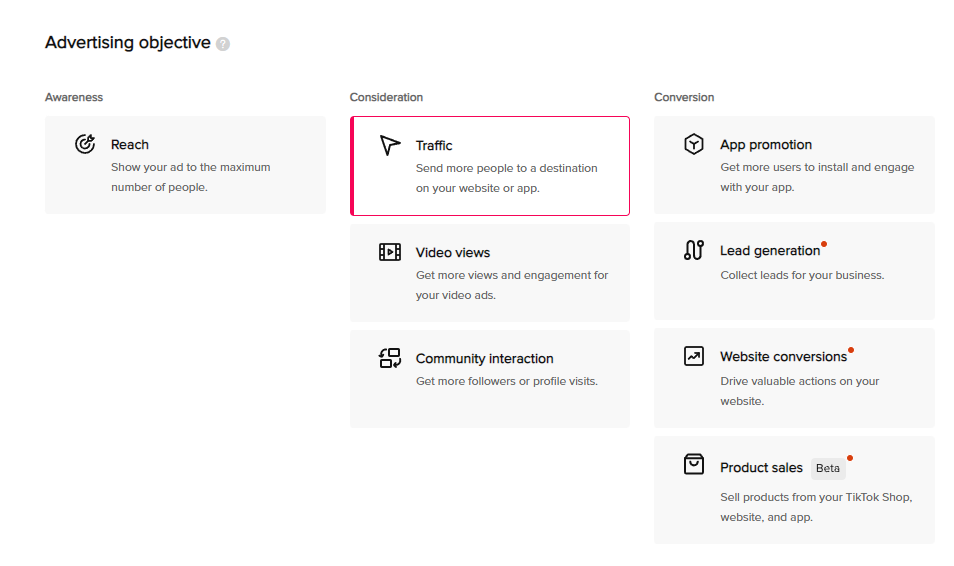
Figure 4: Selecting an advertising objective.
Firstly, awareness campaigns are aimed at sparking interest and enhancing the visibility of a brand, product, or service. These campaigns are designed to reach as many people as possible and create a lasting impression of a brand. Secondly, consideration campaigns are focused on driving engagement and interest. This includes encouraging users to visit a website, interact with content, or follow an account. These campaigns are designed to provide users with more information about a brand, product, or service, and to motivate them to take a specific desired action. Lastly, conversion campaigns are designed to drive users towards a specific action, such as making a purchase or downloading an app.
When creating a TikTok ad campaign to recruit survey participants, we highly recommend setting the campaign objective to “Traffic”, which is categorized under consideration. This objective focuses on driving traffic to a designated landing page, such as your survey website. By selecting this objective, your ad campaign will be optimized to effectively direct users to your survey website, increasing the likelihood of attracting potential participants to take part in your survey. TikTok’s machine learning algorithms will be leveraged to identify users within the target audience who are most likely to take the desired action of clicking on the ad and visiting your landing page.
After selecting the campaign objective, you can proceed to define some essential settings of your campaign. These settings include providing a campaign name and defining a maximum budget for the entire campaign (see Figure 5). While the maximum budget is not mandatory, we recommend setting it as a precautionary measure to prevent your campaign from exceeding the spending limit of your research project.
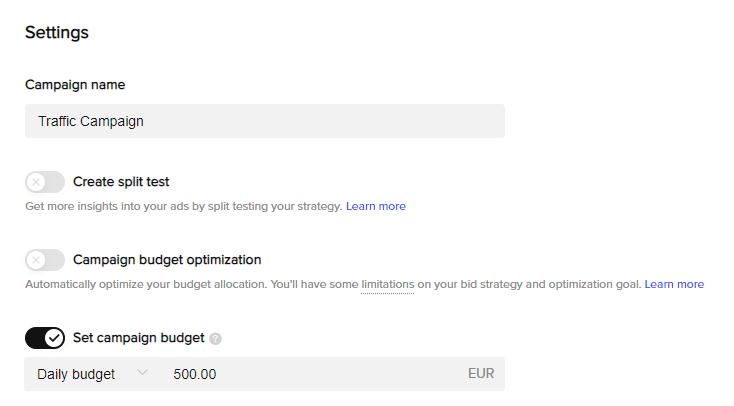
Figure 5: Defining campaign name and campaign budget.
Ad group level
At this level, you can create multiple ad groups within a campaign, each with its own settings tailored to the target audience, thereby enhancing ad effectiveness. You can specify various settings unique to each ad group. These include the optimization location, placements, targeting, budget and schedule, bidding, and optimization. First, set the optimization location, i.e. where to direct traffic. For survey recruitment, the optimization location should be set to the survey website where participants can complete the survey. Under the traffic objective, ad placement in Germany is limited to TikTok and Pangle (see Figure 6). While TikTok is the primary platform where ads will appear, Pangle is an ad network that provides access to third-party apps. We recommend to choose TikTok instead of Pangle, as TikTok has a larger user base and provides more advanced targeting options, which can help you reach a more specific audience. For other countries, other ad placements are available (for an overview see TikTok (n.d.)). Additionally, within the placements section, you have the option to customize your ad settings to control the level of user engagement. Consider deactivating comments to avoid harmful or violent reactions, disabling video downloads to protect your content, and restricting video sharing to ensure that your ads are exclusively viewed within the TikTok platform.
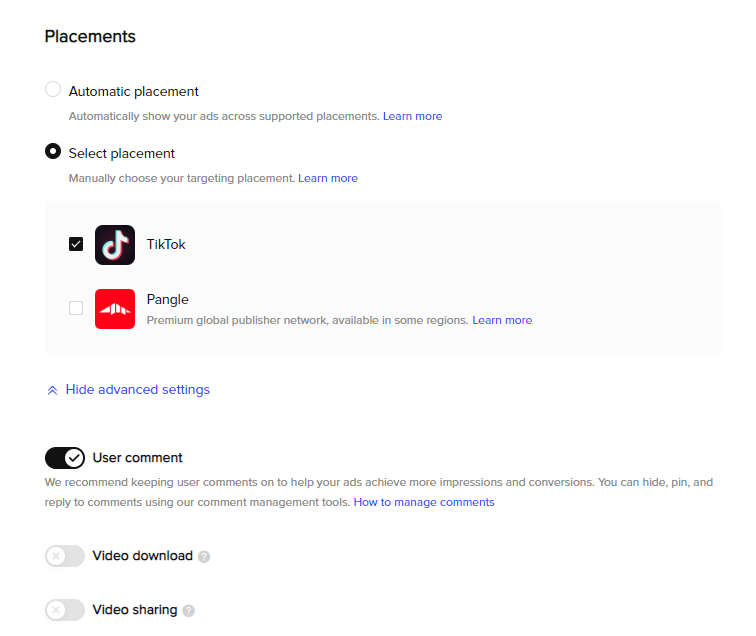
Figure 6: Defining placement options.
Targeting is another crucial step at the ad group level where you define the audience that your ad will be shown to. TikTok provides a range of targeting options, including demographic information, interests, behaviors, and custom audiences. You should define the target audience based on your research objectives and select the appropriate targeting options to effectively reach your desired audience. Take advantage of the wide range of targeting options available when running TikTok ads. Here are some examples:
- Demographic targeting: Gender (binary), age groups, and language preferences (see Figure 7).
- Geographic targeting: Countries/regions you can target using “Location” depending on the country/region associated with your TikTok For Business account. For a comprehensive list of all available locations per country, see TikTok (n.d.).
- Interest-based targeting: Reach users based on their inferred interests, derived from their activity on TikTok (see Figure 8).
- Behavioral targeting: Reach users based on their behavior on TikTok, such as the videos they have liked, shared, or commented on (see Figure 8).
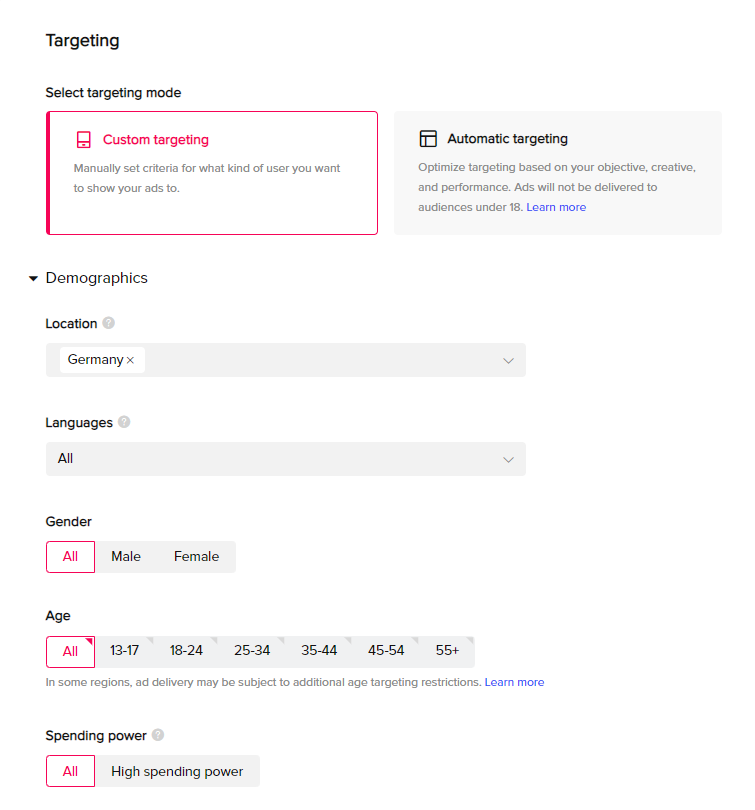
Figure 7: Defining demographic targeting parameters.
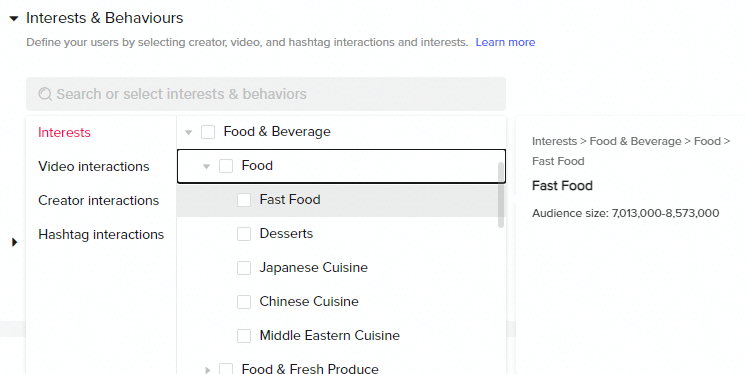
Figure 8: Defining interest- and behavior-based targeting.
It is crucial to ensure compliance with TikTok’s advertising policies and avoid any form of discriminatory targeting towards protected groups. TikTok maintains strict advertising policies to uphold community standards and legal requirements. Advertisers are expected to follow these policies, which are regularly updated, in order to maintain the quality and integrity of the TikTok platform. For a detailed description of all prohibited and restricted content, please refer to TikTok (n.d.).
The next step at the ad group level is to set a budget and schedule. You should define a daily budget for each ad group and specify the display schedule for each group. TikTok offers an estimation of an ad group’s potential reach based on the selected targeting options. This estimation can assist in determining an appropriate budget for your campaign (see Figure 9).
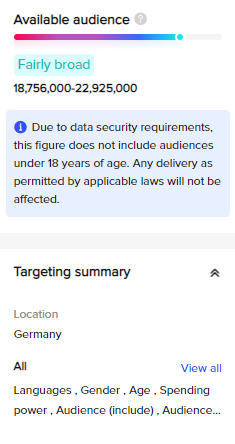
Figure 9: Estimated audience reach.
Once you have set the budget and schedule for your ad group, the next step is to define the options in Bidding & Optimization (see Figure 10). This step determines how the ad will be delivered and optimized for maximum effectiveness. On TikTok, you have the choice between two optimization goals: Click and landing page view. The default and recommended optimization goal is Click, which focuses on driving users to click on the ad and visit the website. Alternatively, the landing page view optimization goal targets users who not only click on the ad but also waits for the landing page to load completely. This is particularly useful for campaigns that require users engagement with the content on the landing page.
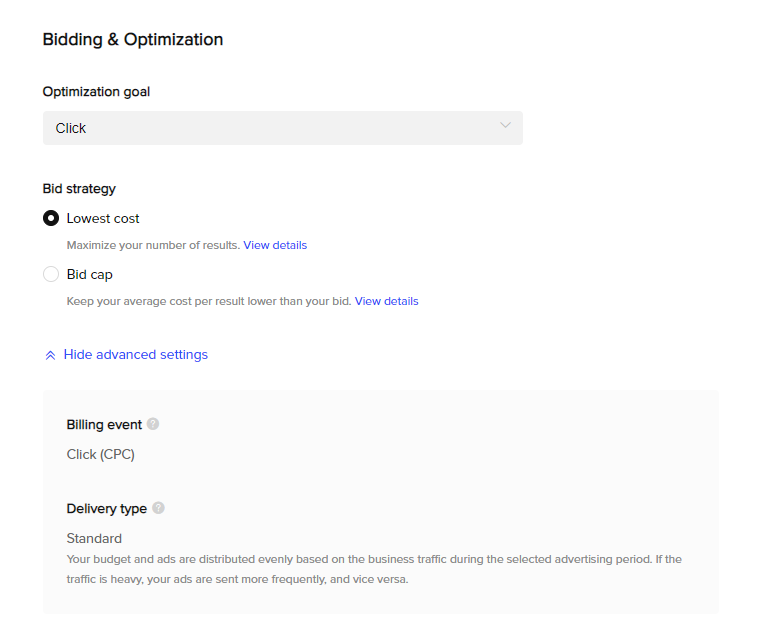
Figure 10: Defining bidding and optimization options.
Furthermore, you also have the option to select between two bid strategies: lowest cost and bid cap. The lowest cost bidding strategy is a spend-based approach, where TikTok’s algorithm automatically adjusts the bid to generate as many results as possible at the lowest cost per result. This strategy is ideal for most campaigns. However, if you want to have more control over the budget allocation, you can choose the bid cap option. With bid cap, you can set a maximum bid amount for each link click, ensuring that the cost per result remains below your predetermined limit. This strategy can be particularly beneficial for campaigns with limited budgets or when you want to ensure that you are not overpaying for each link click.
Ad level
On the ad level, you can create a captivating advertisement that will be displayed to the target audience. The goal is to make the ad highly appealing and drive engagement among your target population. To achieve this, your ad should be eye-catching, and effectively convey the purpose of the survey. Given that TikTok is a platform centered around videos, we highly recommend incorporating a short and captivating video into your ad. The video should grab viewers’ attention and motivate them to take action. While the ad format can also be a single image or image carousel, it is advisable to include at least some dynamic elements to align with the platform’s style. Moreover, you must keep in mind that TikTok ads are primarily optimized for mobile devices. Hence, the ad should be visually appealing and easily viewable on smartphones, ensuring a seamless user experience.
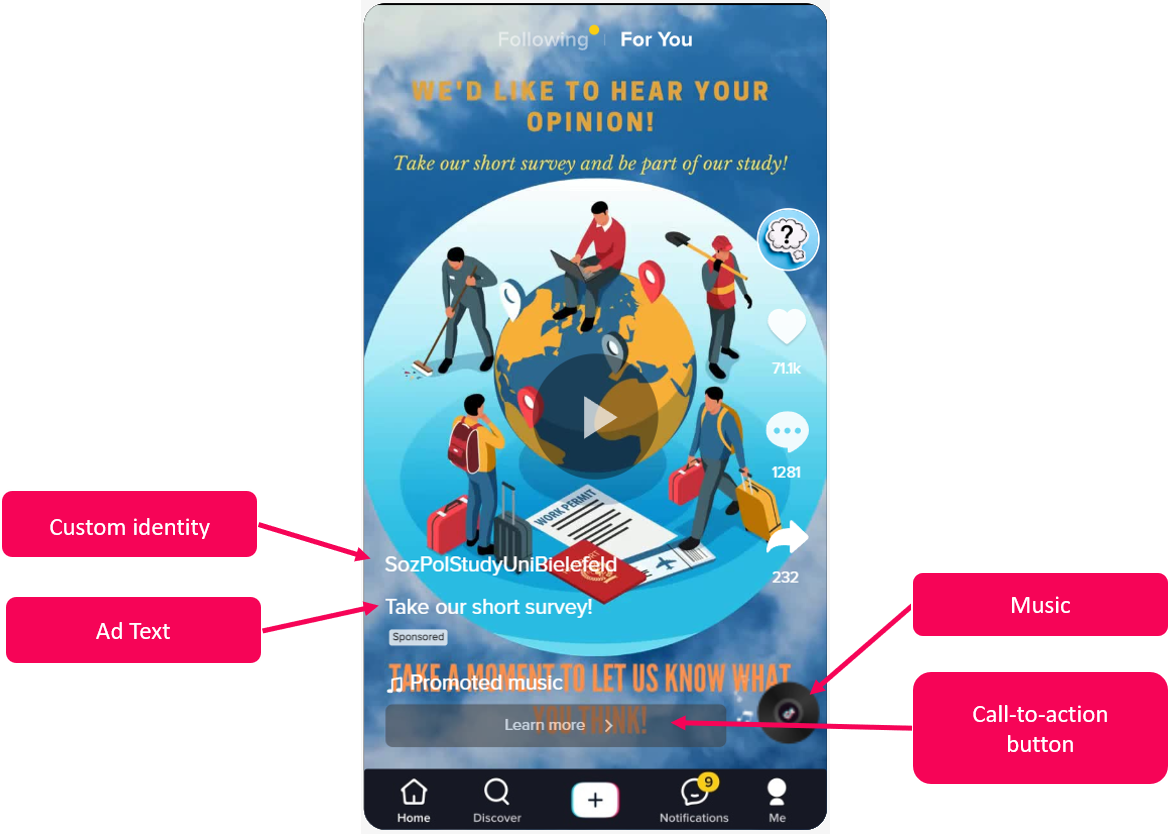
Figure 11: Example ad design.
Source: Image by Macrovector via stock.adobe.com
In addition, you have the option to choose from various call-to-action buttons, such as “Learn More” or “Sign Up”, which are designed to encourage users to take action. When users click on the button, they will be directed to the survey (see Figure 11). Furthermore, it is important to ensure that the ad text and description convey a clear and concise message that motivates users to participate in the survey.
Once the ad campaign is created, it can be launched. However, it is important to note that TikTok will review the ads to ensure compliance with their guidelines and policies. It is essential to avoid displaying prohibited products or services, such as live animals, adult sexual products, casinos, military gear, or political candidates or parties, in the ad creatives or on the landing pages. A comprehensive list of prohibited content can be found at TikTok (n.d.).
Once the ads are live, you can utilize TikTok’s ad manager tool to track their performance. Monitoring the number of views, clicks, and conversions is essential to assess the reach, engagement, and overall effectiveness of the ads. This valuable information can be used to make necessary adjustments to the ad settings and enhance the performance of future ads.
Application example
The following section presents the results of an exemplary TikTok advertising campaign conducted as part of a master’s seminar at Bielefeld University. In this seminar, students were tasked with designing a questionnaire aligned with their individual research interests. The main topics were attitudes toward refugees and youth crime in the UK and Germany. To efficiently and cost-effectively generate a substantial sample size, the study was promoted through TikTok ads.
Ad campaign details
In accordance with the previously discussed hierarchical structure, various settings were configured at the three different levels of the advertising campaign (see Table 1).
At the campaign level, we opted for a consideration advertising objective, specifically “Traffic”, with the aim of driving traffic to our survey website. We set the maximum budget of 400.00 EUR for the entire study. Moving on to the ad group level, we created three distinct ad groups: one targeting English-speaking individuals in the UK (ad group: UK), another targeting German-speaking individuals in Germany (ad group: DE1), and a third focusing on English speaking-individuals in Germany (ad group: DE2). While these ad groups differed in terms of location and language targeting, certain settings were kept consistent across all three: age range, gender, maximum budget per ad group, schedule, delivery, bid strategy, optimization goal, and billing event. For each ad group, we allocated a maximum budget of 130.00 EUR, aiming to evenly distribute our budget across the ad groups. The recruitment phase was scheduled to run from August 6th, 2022, at 16:00 to August 9th, 2022, at 16:00. We configured all ad groups to deliver ads throughout the day, and the optimization goal for each group was to maximize clicks on the advertisements. To minimize costs while maximizing the number of clicks, we selected the “lowest cost” bid strategy. Based on our settings, the billing event was set to cost per click (CPC).
We created a total of 15 ads, with five ads designed under each of the three ad groups. These ads included either a video or an image with animations. As an example, Video 1 illustrates an ad tailored to address the topic of juvenile delinquency, and was specifically targeted to the English-speaking target population. In addition to the visuals, each ad featured our custom identity (@SozPolStudyUniBielefeld), license-free background music provided through TikTok, and concise yet meaningful ad texts, such as “Take our short survey!” in the corresponding language of the target group. To encourage user engagement, we utilized the “Learn more” call-to-action button. When users clicked on this button, they were redirected to our survey page, and we employed URL parameters to track from which respective ad participation in the survey took place.
Source: Video by cottonbro via Canva.com
Campaign results
Table 2 provides an overview of the ad campaign’s performance metrics. Over the course of the 4-day campaign, it reached a total of 117,626 TikTok users. The videos or animated images were played 189,100 times, with the ads being displayed 205,071 times, as reported by the TikTok Ad Manager. The campaign incurred a total cost of 387.48 EUR and generated 3,603 clicks on the call-to-action button, representing a click-through rate of 1.76 percent. The average cost per click was 0.11 EUR, which is comparable to recruitment via other social media platforms like Facebook or Instagram (cf. e.g., Zindel 2022).
Analyzing the ad performance reveals variation depending on the target groups. Ads placed in Germany (ad groups: D1 & D2) reached a higher overall number of impressions compared to the UK. This discrepancy can be attributed to the less developed TikTok ads market in Germany compared to the UK, resulting in lower costs for link clicks due to reduced ad competition. Consequently, the same ad budget resulted in varying levels of impressions. Figure 12 illustrates the cost per click (CPC) by ad group. Initially, during the learning phase of the advertising algorithm, ads in the UK were slightly more expensive than those in Germany. Moreover, the ad group targeting English speakers in Germany (ad group: DE2) exhibited the highest cost per click over the short duration of the campaign. This can be attributed to the relatively lower proportion of TikTok users in Germany who use the platform in English compared to those who use it in German. Targeting a smaller user base incurs higher costs to reach a significant number of users, as reflected in the number of impressions in Table 2.
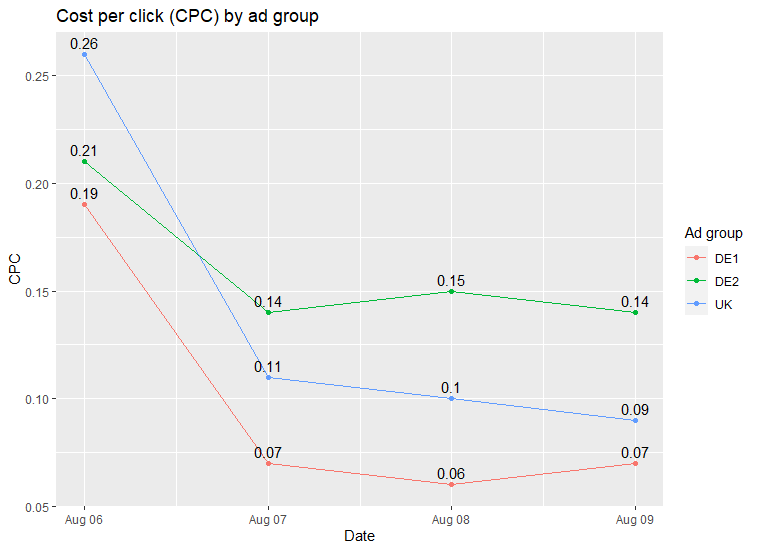
Figure 12: Average cost per click (CPC) for each ad group.
Examining the metrics distribution in Table 2 highlights significant variations in ad performance. Some ads were displayed and viewed more frequently than others within the same ad group. For instance, in ad group DE2, the ad YD2DE2, one of two ads that focused on the topic of youth delinquency (“YD” for short), had the highest allocation rate determined by the advertising algorithm, resulting in the highest number of clicks on the call-to-action button within this group. When considering the click-through-rate (CTR) for all ads, which represents the conversion rate from impressions to clicks, ads served more frequently tended to have comparatively higher CTRs. However, it is important to note that these ads may not necessarily have the highest CTR within their respective ad groups. For example, in the UK ad group, the ad RF2UK had a CTR of 2.66 percent, surpassing the most frequently displayed ad YD2UK with a CTR of 2.22 percent. This discrepancy arises from the fact that ads that initially garner significant attention in the initial learning phase of the advertising algorithm may not necessarily sustain the highest level of interest from the target audience throughout the entire ad runtime TikTok (n.d.).
Table 3 presents the conversion of link clicks per ad into started and completed interviews, along with the corresponding total cost and cost per completed interview. Out of the 3,603 link clicks, 1,846 (51.29 percent) resulted in started interviews, and a total of 500 interviews (13.88 percent) were completed. With a total campaign cost of 387.48 EUR, the average cost per completed interview was 0.77 EUR. Notably, variations can be observed across the ad groups. The ad group targeting German-speaking individuals in Germany (DE1) received the highest number of link clicks (n=1,676), resulting in the highest number of started interviews (n=983; 58.65 percent), as well as completed interviews (n=265; 15.81 percent). This specific target group was also the most cost-effective to reach, with an average cost of 0.49 EUR per completed interview. In contrast, the average cost per completed interview was 0.99 EUR for the DE2 ad group and 1.23 EUR for the UK group. This disparity highlights the differences in costs discussed earlier, which are influenced by the bidding system and the ad algorithm.
Sample composition
The final sample comprises three subsamples derived from the three different ad groups: English-speaking individuals in the UK (ad group: UK), German-speaking individuals in Germany (ad group: DE1), and English-speaking individuals in Germany (ad group: DE2). Group DE1 accounts for 265 completed interviews, representing 53.00 percent of all interviews. Group DE2 includes 130 interviews (26.00 percent) and group UK has 105 interviews (21.00 percent). The average age of the respondents is 37.22 years (see Figure 13), which is higher than expected considering TikTok’s popularity among younger generations. However, it is important to note that the average age in our sample still falls below the overall average age of 44.7 in the German population (Statistische Ämter des Bundes und der Länder, 2022) and the median age for the UK (UN DESA, 2022).
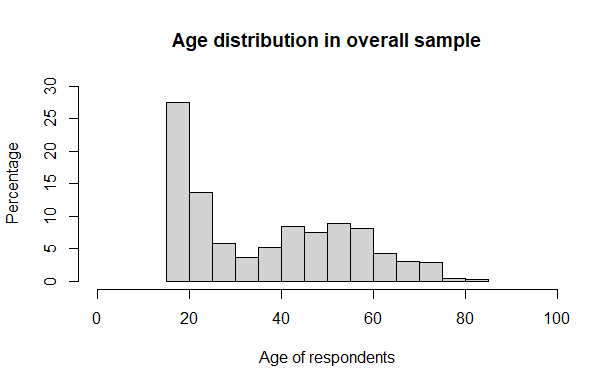
Figure 13: Age distribution in overall sample.
The average age within the DE1 ad group is 47.74 years, whereas it is 23.99 years for the DE2 ad group and 25.53 years for individuals in the UK. This indicates a strong selection bias towards older individuals in the German-speaking group, while the other ad groups exhibit a strong bias towards younger participants. Table 4 compared the age distribution of each ad group with the ad allocation information provided by TikTok. These selection effects are primarily influenced by the ad algorithm. Therefore, for studies aiming to achieve a demographically balanced age distribution, it is recommended to further stratify ad groups and run specific ads targeted at different age groups to mitigate similar age biases.
Regarding gender distribution, a larger proportion (61.52 percent) of male participants was identified in the sample, while only 27.05 percent identified as female (see Table 5). Additionally, 60 individuals (11.43 percent) in the sample reported identifying with a different gender. A comparison of the sample data with the information from the TikTok Ads-Manager reveals that this effect can also be partially attributed to the allocation of the ads by the advertising algorithm. The DE1 ad group was predominantly delivered to men, while the DE2 and UK ad groups did not exhibit such a strong gender effect in their ad display. It appears that a large proportion of respondents, assumed to be female, chose the third response option, “another gender”. However, it is important to note that we lack individual gender information within the TikTok platform.
Ethical considerations
When considering the use of TikTok for survey recruitment and advertisements in general, several ethical implications merit careful consideration. TikTok, a Chinese company owned by ByteDance with established ties to the Chinese state, raises pertinent concerns. Purchasing advertising space on this platform contributes to TikTok’s financial revenue, strengthening its market position as one of the fastest-growing social media platforms. Due to its indirect connection to the Chinese state, numerous government agencies, such as the European Commission and the European Council, have banned TikTok from their official devices. Moreover, some countries have opted for a complete prohibition of TikTok due to concerns encompassing cyber security, privacy, and misinformation.
With the approach outlined in this blog post, TikTok does not have access to the survey data at any time. The social media platform remains incapable of identifying which users have participated in our survey. To ensure that the survey data remains inaccessible to third parties at all times, we strongly advise against the utilization of tracking tools provided by TikTok, as well as other platforms.
Nonetheless, it is worth noting that TikTok creates interest profiles of users based on their interaction with advertised content – a practice also common among other social media platforms. However, considering TikTok’s indirect link to the Chinese state, the possibility that these interest profiles could be accessed by Chinese authorities cannot be disregarded. This potential vulnerability is especially concerning for marginalized population groups, such as LGBTQI* individuals. While TikTok may lack specific information regarding the gender or sexual identity of its users, it can infer from users’ interactions with content related to LGBTQI* topics that these users at least hold an interest in such matters.
For all researchers intending to establish financial collaborations with TikTok –- whether to recruit survey participants or promote other content –- we strongly recommend a preliminary consultation with their respective institutions, employers, and ethics committees. This step will help determine the feasibility of such projects within the ethical framework.
Summary and key takeaways
Recruiting survey participants through TikTok ads offers several advantages for researchers. TikTok’s vast and diverse user base allows access to a broad range of potential participants, and its targeting options enable reaching specific populations that may be challenging to reach through traditional methods. By following our presented step-by-step guide for setting up advertisements on TikTok, you can effectively generate a diverse and inexpensive sample for your web surveys. The example of a TikTok advertising campaign demonstrates the platform’s potential in efficiently and cost-effectively recruiting survey participants. We delved into its unique features, demographics, and engagement levels, considering its suitability for reaching a diverse audience. Additionally, we examined the advantages and disadvantages of utilizing TikTok, highlighting its ability to generate rapid and widespread exposure while also acknowledging the challenges it presents, such as limited insights in the algorithmic ad allocation and potential for high selectivity.
Overall, the key takeaways from this tutorial are as follows:
- TikTok offers a vast user base with diverse demographics, making it a promising platform for survey recruitment efforts aimed at reaching a wide audience.
- Ad campaigns on TikTok are structured into campaign levels, ad group levels, and ad levels, each requiring informed choices and necessary information for effectiveness.
- TikTok provides various targeting options, including demographics, interests, behaviors, and custom audiences, to reach the desired audience.
- Ad creatives on TikTok should be eye-catching, incorporate videos or dynamic elements, and have clear ad text and call-to-action buttons.
- It is essential to carefully monitor and address potential ethical concerns, such as data privacy and user consent, when utilizing TikTok for survey recruitment.
- Monitoring the performance of TikTok ads through the ad manager tool is crucial for assessing reach, engagement, and effectiveness, especially when it becomes apparent that certain ad groups outperform others.
- The distribution of ads by the algorithm may lead to overrepresentation of different subgroups. For demographically more comparable population distributions, it is recommended to stratify the ads using the targeting parameters.
Further reading
Here are several publications that offer a valuable introduction to the topic of social media ads for survey respondent recruitment.These publications provide valuable insights into the use of social media ads for recruiting survey respondents and serve as a great starting point for exploring this subject further:
- Iannelli, L., Giglietto, F., Rossi, L., & Zurovac, E. (2020). Facebook Digital Traces for Survey Research: Assessing the Efficiency and Effectiveness of a Facebook Ad–Based Procedure for Recruiting Online Survey Respondents in Niche and Difficult-to-Reach Populations. Social Science Computer Review, 38(4), 462–476. doi:https://doi.org/10.1177/0894439318816638
- Kühne, S., & Zindel, Z. (2020). Using Facebook and Instagram to Recruit Web Survey Participants: A Step-by-Step Guide and Application. Survey Methods: Insights from the Field. doi:https://doi.org/10.13094/SMIF-2020-00017
- Neundorf, A., & Öztürk, A. (2021, July 26). How to Improve Representativeness and Cost-effectiveness in Samples Recruited through Meta: A Comparison of Advertisement Tools. url:https://doi.org/10.31219/osf.io/3g74n
- Neundorf, A., & Öztürk, A. (2021, December 9). Recruiting Research Participants through Facebook Advertisements: A Handbook. url:https://doi.org/10.31219/osf.io/87rg3
- Zindel, Z. (2022). Social Media Recruitment in Online Survey Research: A Systematic Literature Review. methods, data, analyses, 0, 42. doi:https://doi.org/10.12758/mda.2022.15
We would also like to highlight the excellent webinar series of the DEMED project. This series offers a range of insightful presentations that delve into the advantages of social media for survey research.
